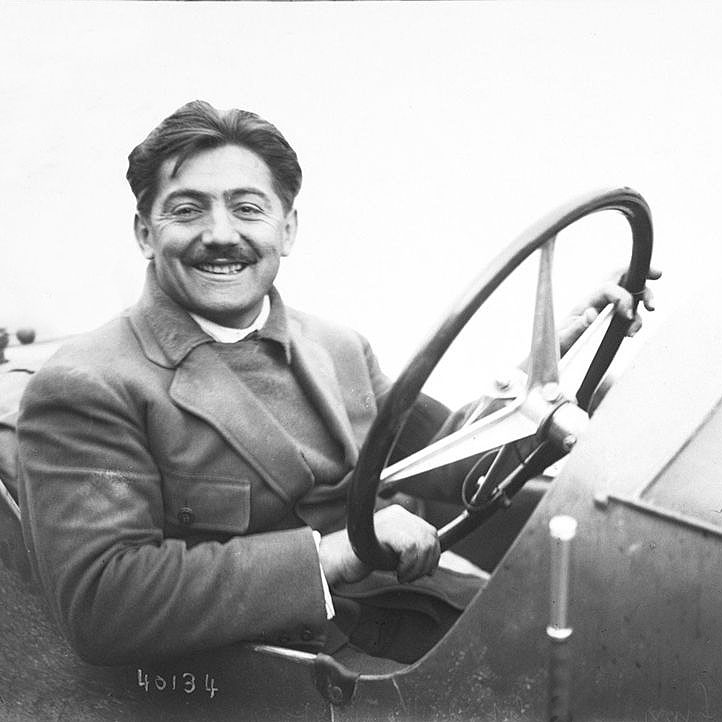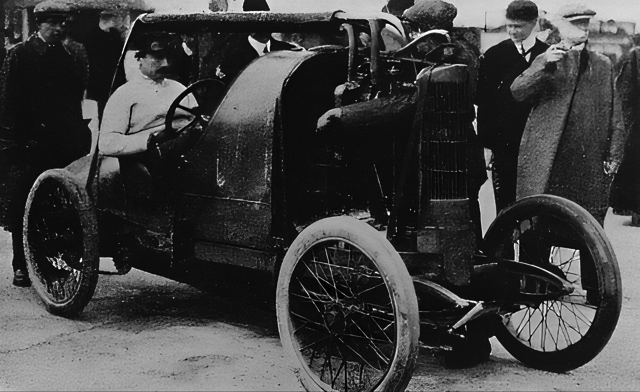3/8/1884 - 21/4/1916
Record updated 21-Apr-23
Georges Boillot was the top French Grand Prix driver pre WWI and a fighter pilot during the ensuing war. He was shot down near Verdun in a dogfight with a squadron of German fighters during WW1.

Georges Louis Frederic Boillot was born in Valentigney, France, the son of Louis Boillot, who worked for one of the Peugeot brothers, and Catherine Jeanperain. A mechanic by training, as were many early racing drivers, Boillot started racing in 1908 joining Paul Zuccarelli and Jules Goux in the Lion-Peugeot Voiturette team. Lion-Peugeot was the automobile department of Les Fils de Peugeot Freres and was so named to avoid confusion with La Société des Automobiles Peugeot's cars.
Voiturette rules had originally designed to deliberately favour single-cylinder engines and Lion-Peugeot’s first efforts were fairly conventional. However the rules also, unintentionally, encouraged the use of long-stroke engines as this option permitted an extra 500cc capacity over the short stroke option. The Lion-Peugeot engines became taller and taller in the search for more power and the Louis Verdet designed Lion-Peugeots were the class of the field, their single cylinder engines featuring a 100mm bore, a 250mm stroke and six valves: three inlet and three exhaust!
And so it was that at the end of April 1909, Georges Boillot made his debut in the Corsa Vetturette Madonie retiring before half distance and he failed to finish again a month later on the banking at Sitges in the Copa Catalunya.
On June 20th he raced in the Coupe de l'Auto des Voiturettes in Boulogne (the ACF Voiturette Grand Prix). The previous year it had been a support race to the Grand Prix de l'ACF but was now the feature race. Delage, who had won in 1908, didn't enter. The race was won by Giosué Giuppone with Boillot coming home a creditable 4th, setting the fastest lap at 52.78 mph on his way.

Just four weeks later he took his first win, crossing the line in the Coupe de Normandie ahead of Rene Thomas and his team mate Giosué Giuppone. Once again setting the fastest lap at an average speed of 68.97 mph.
In November he travelled to the UK and Brooklands with his Coupe de l'Auto des Voiturettes car and set a number of new records for the Voiturette class. He set the one hour record covering 68 miles 688 years and also set records at the half mile mark and at 50 and 100 miles.

At the 1910 Coupe des Voiturettes
In 1910 even longer strokes were permitted and the Lion-Peugeot team’s engineers had become so specialised in this field that when they expanded into multi-cylinder engines, they kept the same format. With the V4 Lion-Peugeot, which now had a 65 mm bore and 260 mm stroke engines giving a capacity of 3451cc, Boillot travelled to Italy in May for fifth running of the Targa Florio and won the Sicilian Cup, the Voiturette class, in a Lion-Peugeot 1-2-3 with Giuppone second and Jules Goux in third.
He finished second in both the Coupe d'Ostende and the Coupe de Normandie and, in September at the Coupe de l'Auto des Voiturettes, the main Voiturette race of the year, tragically, Giuppone was killed in practice when a bicycle ran in front of him as he raced through Wirwignes. He had to swerve suddenly and with such a high centre of gravity, he lost control of his Lion-Peugeot and rolled. He was pronounced dead at the scene though his riding mechanic escaped with just minor injuries. In the race Georges could only manage 4th with the V4 though Goux finished second with a twin cylinder model. Georges also won the Mont Ventoux hillclimb that year.
Ultimately Lion-Peugeot's technology didn’t translate well into their road cars and (who’d have guessed?) it proved to be a technical dead end and the long-stroke Lion-Peugeots came to be considered something of a Dodo.
That year Les Fils de Peugeot Freres merged with La Société des Automobiles Peugeot to form Société Anonyme des Auto-Mobiles et Cycles Peugeot (catchy little name). The racing department of Lion-Peugeot went with it however the new company had little interest in Voiturette racing and commissioned their new racing department to build them a Grand Prix car.
Nicknamed 'The Charlatans' in the Peugeot factory and operating out of a number of small workshops around Paris, Hispano-Suiza designers, the young Swiss engineer Ernest Henry and Paul Zuccarelli, along with Goux and Boillot, designed the first engine to feature dual overhead camshafts and four valves per cylinder. It was one of the landmark designs in motor racing history and, for the 3 years between 1911 to 1913, they swept all before them.
Armed with the best equipment available, Georges Boillot became the leading driver of the immediate pre-WW1 period, only the great Felice Nazzaro was probably more talented, but he'd stepped away from Grand Prix racing in order to delve into the commercial side of motoring, and Georges' only consistent challengers were his own team mates, Jules Goux, Paul Zuccarelli, Rene Thomas and Dario Resta.

In 1912 he took over responsibility for the management of the racing department at Levallois-Perret and continued with this role along with his driving until the department was closed in 1914.
At Dieppe, France, on June 26, 1912, Georges won the French Grand Prix in his Peugeot L76 and won the Coupe de l'Auto in 1913 and became the darling of French racing fans when he won his second straight French Grand Prix at Amiens. He also won the Mont Ventoux hillclimb again in 1912 and 1913.

That same year, his Peugeot teammate, Jules Goux became the first Frenchman to win the Indianapolis 500 in the United States. The following year the French sent a number of competitors to the Indiana speedway where on May 27, during qualification runs, Georges Boillot came tantalizing close to breaking the 100 mile-an-hour barrier when he set a new speed record of 99.860 mph. Much faster than any other driver, Boillot would most likely have won the race with ease had it not been for repeated tire trouble. He ended up finishing 14th while his fellow Frenchmen finished in the top four positions with René Thomas getting the win.
Ironically it was the Germans, in the guise of Mercedes, who would finally rise to the technical challenge and, in what would turn out to be his last race before the onset of the WWI, the 1914 French Grand Prix at Lyon, he was beaten by Christian Lautenschlager in a Mercedes.
In what is often considered to be his finest race, Boillot demonstrated all his tremendous skills to keep the Peugeot running. With the car literally falling apart around him, it finally overheated on the last lap forcing him to retire, handing victory to Lautenschlager. Lautenschlager had never been in the same league of driving talent as Georges and his victory owed everything to the superiority of his Mercedes.
With the outbreak of war Georges, who had entered military service in October 1915 serving with the 21st Infantry Regiment with responsibility for driving the commander-in-chief, General Joseph Joffre, to help him keep in touch with the various units under his command. But looking for action he requested to join the newly formed Armee de L'Air as a fighter pilot. He had qualified as a pilot in 1911 and served in action initially with Escadrille N.49 and then N.65.
He was credited with three kills. He was awarded the Légion d'Honneur on April 9th, the Croix de Guerre on May 15th but then lost his life four days later when his red Nieuport was shot down during a dog-fight over the French town of Bar-le-Duc, near the killing fields of Verdun-sur-Meuse. Having engaged a number of German fighters (accounts range from four to seven), he shot one down (his 4th kill) before coming off second-best to the Germans for the second and final time probably at the hands of the German Ace Lieutenant Oswald Bölcke. Severely injured, he died in a military hospital at Vadelaincourt, Meuse.
His funeral ceremonial took place in Vadelaincourt on Sunday 21st May with French Ace Jean Navarre and Charles Nungesser flying over and dropping flowers.
Navarre was tragically killed on the 10th July 1919 at Villacoublay aerodrome while practicing to fly through the Arc de Triomphe as part of the victory parade that had been planned on the Champs Élysées for the 14th. Nungesser disappeared while attempting the first non-stop transatlantic flight from Paris to New York in 1927.
When racing resumed in 1919, Peugeot returned, and initially they seemed to be going to pick-up where they left-off with Georges' younger brother André winning the 1919 Targa Florio. However neither André nor Peugeot would play a major roll in Grand Prix racing beyond that first season. André did continue racing until he crashed a Peugeot 201 in practice for the 1932 Ars hillclimb at La Châtre. He died in hospital a few days later from his injuries.
Apparently according to Griffith Borgeson, Boillot invented the knock-off cap for Rudge-Whitworth wire wheels. Also according to Peugeot's archives, Jean Boillot, who was Peugeot sales director until 1974 and chairman until 1990, was not related to Georges.
There is a joint memorial to Georges Boillot and Robert Benoist at the junction of the Avenue Georges Boillot and the Chemin Bois du Faye, Linas, France, at the entrance to the Autodrome de Linas-Montlhéry.
historicracing.com with input from Richard Davilla